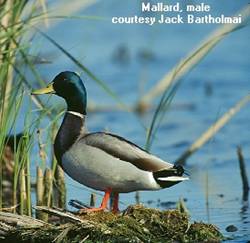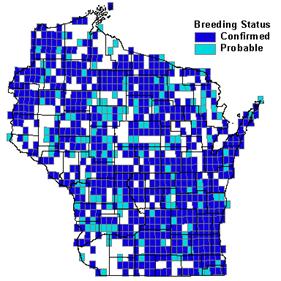

Status/Protection
- Global Rank: G5 Key to global and state ranks
- State Rank: S5B
- WBCI Priority: WFOWL
Population Information
The Federal BBS information can be obtained at http://www.mbr-pwrc.usgs.gov/bbs/bbs.html by clicking on Trend Estimates and selecting the species in question. All estimates are for time period (1966-2005).
- Federal Breeding Bird Survey: significant increase
- Federal Breeding Bird Survey (WI): significant increase
- Federal Breeding Bird Survey (BCR 23): non-significant increase
- Federal Breeding Bird Survey (BCR 12): non-significant increase
- Waterfowl Breeding Population and Habitat Survey: stable (1955-2005: USFWS 2006)
- Wisconsin Spring Duck Survey: increase (1973-2006: Van Horn et al. 2006)
- WSO Checklist Project: significant increase (1983-2007)
Life History
- Breeding Range: Most extensive breeding range of any duck in North America; breeds throughout much of Canada and the U.S. but absent from areas of the southern U.S.; also across Europe and Asia (Drilling et al. 2002).
- Breeding Habitat: Northern Sedge Meadow and Marsh, Southern Sedge Meadow and Marsh, Inland Open Water, Emergent Marsh, Wild Rice, and various grassland cover types.
- Nest: Often a scrape in upland area near water but will nest on a variety of substrates (Drilling et al. 2002).
- Nesting Dates: Eggs: late March to late August (Martin and Martin 2006).
- Foraging: Dabbles (Ehrlich et al. 1988).
- Migrant Status: Short-distance migrant, Permanent resident.
- Habitat use during Migration: Row Crop, Great Lakes Open Water; shallow wetlands, flooded fields, bottomland lakes (Drilling et al. 2002).
- Arrival Dates: Early March to early May (Robbins 1991).
- Departure Dates: Mid-August to mid-December (Robbins 1991).
- Winter Range: Southern Canada south throughout U.S. and northern Mexico (Drilling et al. 2002).
- Winter Habitat: Open water areas of reservoirs, ponds, marshes, shallow wetlands (Drilling et al. 2002).
Habitat Selection
Mallards use a wide variety of habitats for feeding and nesting but ideal habitat conditions consist of diverse wetland complexes and upland cover in contiguity (Kaminksi and Weller 1992). Ephemeral, seasonal, and semipermanent wetlands and ponds are important for breeding pairs and broods. Mallards generally nest in areas with tall, dense vegetation (Evrard 2002) often within 150 meters of water (Drilling et al. 2002). In Wisconsin, residual switchgrass and bromegrass constituted the dominant vegetation around the nest site (Evrard 2002). Nests have been documented in a variety of locations, including idle grasslands, croplands, marshes, pastures, and roadside ditches (Drilling et al. 2002) as well as natural and constructed islands and artificial structures in wetland basins (Kaminski and Weller 1992, Chouinard et al. 2005), which may provide more protection from predators and thus higher nest success (Kaminski and Weller 1992). Urban Mallard also nest in less traditional substrates, including lawns, lakeshore developments, flat roofs (J. March, pers. comm.), ornamental shrubs, gardens, and woodpiles (Drilling et al. 2002). Emery et al. (2005) also found that managed cover types within the Prairie Pothole Region, such as planted cover and hayfields with delayed harvest, provided high early-season nesting success.
Mallards opportunistically respond to available habitat during migration and winter. Small ponds, marshes, streams, rivers, flooded fields, and reservoirs may be used during spring and fall migration. Urban ponds, exposed riverine areas, and other areas of open water close to a steady food source will provide refuge in the winter (Drilling et al. 2002). Mallards are able to withstand cold temperatures (Drilling et al. 2002) and remain in relatively large concentrations in southern Wisconsin during the winter (Robbins 1991).
Habitat Availability
Mallard is the most common nesting duck of Wisconsin and is found in a diversity of natural and urban settings. As a result of this habitat plasticity, Mallards are widespread throughout the state in all seasons (Robbins 1991). Nevertheless, continued wetland loss in Wisconsin is a concern for the state population. Prior to Euro-American settlement, wetlands occupied an estimated four million hectares of the total fourteen million hectares of Wisconsin’s land area. Today, 2.1 million hectares (53%) of these wetland habitats remain (WDNR 1995). Additionally, the amount and quality of undisturbed upland habitat in Wisconsin is limited. Intensive agriculture and urban development have caused major long-term losses in secure nesting cover (WDNR 1992). Early harvesting of these croplands may result in nest loss and hen mortality and have serious conservation implications (Petersen et al. 1982, WDNR 1992). Fortunately, efforts are underway to address these losses. The Conservation Reserve Program (CRP) and other set-aside acreages have increased upland cover in recent years (WDNR 1992) and provided secure nesting habitat. Additionally, the Upper Mississippi River/Great Lakes Region Joint Venture has protected, enhanced, or restored more than 51,000 hectares of upland habitat in Wisconsin as well as 37,000 hectares of wetland habitat. Strict wetland use regulations and incentive programs designed to restore or enhance wetlands also help to curb habitat loss and protect existing wetlands (WDNR 1995).
Population Concerns
Several long-term studies, including the Breeding Bird Survey, Waterfowl Breeding Population Survey for Wisconsin, and Wisconsin Checklist project, report an increasing population trend for Mallards (Rolley 2005, Sauer et al. 2005, Van Horn 2006). Mallards are a common winter resident in south and central Wisconsin, an abundant migrant, and a common summer resident throughout the state (Robbins 1991). During the Wisconsin Breeding Bird Atlas (1995-2000), observers confirmed Mallard as breeding in 57% of the surveyed quads (Martin and Martin 2006).
Large-scale alterations of wetlands and grasslands by agriculture, urbanization, and industrial activities impact populations. Mallards are the most harvested waterfowl species in North America and are thus the most studied and intensively monitored duck species. Annual breeding surveys, banding and research across North America assure that hunting regulations are adjusted annually to maintain a stable continental population (Drilling et al. 2002).
Recommended Management
Management efforts should focus on protecting remaining grasslands, particularly in those areas where numerous wetlands exist. Managers should consider establishing idle grasslands adjacent to existing wetlands to provide nesting cover. The recommended patch size for a nesting area is 32-40 ha, preferably in a square-like configuration (Petersen et al. 1982). However, landscape-level programs such as CRP may be more meaningful than actions that focus only on increasing nesting habitat patch size (Reynolds et al. 2001). Maintenance of optimal nesting habitat may require active management, e.g., allowing dead vegetation to accumulate and periodic burning, grazing, or mowing to prevent it from becoming too dense. However, managers are advised to conduct management activities during the non-breeding season to minimize disturbance on nesting birds (Sample and Mossman 1997).
Collaborative efforts to implement the habitat protection, restoration, and acquisition recommendations identified in the North American Waterfowl Management Plan will benefit Mallards and other wetland-associated species. In Wisconsin, managers should consider the following criteria for future acquisitions: (1) the presence of >16 ha of uplands capable of dense nesting cover; (2) at least 40 pairs of dabbling ducks within 0.8 km of the tract; (3) available brood habitat within 0.8 km of the tract; and (4) a minimum ratio of 1:4 brood water to upland nesting cover, or at least 4 ha of secure brood habitat within 0.8 km of the proposed tract (Petersen et al. 1982). Furthermore, wetland drawdowns that encourage growth of mudflat annuals, regenerate stands of emergent vegetation, stimulate primary productivity, and in turn improve the detrital base also should benefit Mallards (Kenow and Rusch 1996).
Research Needs
The effects of landscape factors on demographics and recruitment warrant further study. More research is needed to identify source and sink habitats and factors influencing the suitability of brood ponds. Long-term studies also are needed to determine lifetime reproductive success and factors influencing recruitment (Drilling et al. 2002).
Information Sources
- Cornell Lab of Ornithology species account: http://www.birds.cornell.edu/AllAboutBirds/BirdGuide/Mallard.html
- Jahn, L.R. and R.A. Hunt. 1964. Duck and coot ecology and management in Wisconsin. Technical Bulletin (33):1-212. Wisconsin Department of Natural Resources, Madison.
- North American Breeding Bird Survey: http://www.mbr-pwrc.usgs.gov/bbs/bbs.htm
- Temple, S.A., J.R. Cary, and R. Rolley. 1997. Wisconsin Birds: A Seasonal and Geographic Guide. Wisconsin Society of Ornithology and Wisconsin Department of Natural Resources, Madison, WI.
- Upper Mississippi River Great Lakes Joint Venture Implementation Plan: http://www.fws.gov/midwest/NAWMP/documents/WaterfowlManagementPlan.pdf
- Waterfowl Population Status report: http://www.fws.gov/migratorybirds/reports/status06/waterfowl%20status%202006.pdf
- Wisconsin Breeding Bird Atlas http://www.uwgb.edu/birds/wbba/
- Wisconsin Department of Natural Resources (WDNR). 1992. Upper Mississippi River and Great Lakes region joint venture – Wisconsin plan. Madison, WI.
References
- Chouinard, M.D., R.M. Kaminski, P.D. Gerard, and S.J. Dinsmore. 2005. Experimental evaluation of duck nesting structures in Prairie Parkland Canada. Wildlife Society Bulletin 33(4): 1321-1329.
- Drilling, N., R. Titman, and F. McKinney. 2002. Mallard (Anas platyrhynchos). In The Birds of North America, No. 625 (A. Poole and F. Gill, eds.). The Birds of North America, Inc., Philadelphia, PA.
- Ehrlich, P.R., D.S. Dobkin, and D. Wheye. 1988. The birders handbook: a field guide to the natural history of North American birds. Simon & Schuster, Inc. New York.
- Emery, R.B., D.W. Howerter, L.M. Armstrong, M.G. Anderson, J.H. Devries, and B.L. Joynt. 2005. Seasonal variation in waterfowl nesting success and its relation to cover management in the Canadian prairies. Journal of Wildlife Management 69(3): 1181-1193.
- Evrard, J.O. 2002. Duck production and harvest in St. Croix and Polk counties, Wisconsin. Technical Bulletin (194): 1-38. Wisconsin Department of Natural Resources, Madison.
- Kaminski, R.M. and M.W. Weller. 1992. Breeding habitats of nearctic waterfowl. Pages 568-589 in B.D. J. Batt, A.D. Afton, M.G. Anderson, C.D. Ankney, D.H. Johnson, J.A. Kadlec, and G.L. Krapu, editors. Ecology and management of breeding waterfowl. University of Minnesota Press, Minneapolis, USA.
- Longcore, J.R., D.G. McAuley, G.R. Hepp, and J.M. Rhymer. 2000. American Black Duck (Anas rubripes). In The Birds of North America, No. 481 (A. Poole and F. Gill, eds.). The Birds of North America, Inc., Philadelphia, PA.
- Martin, M. and S. Martin. 2006. Mallard. In Atlas of the Breeding Birds of Wisconsin. (N.J. Cutright, B.R. Harriman, and R.W. Howe, eds.) The Wisconsin Society for Ornithology, Inc. 602pp.
- Petersen, L.R., M.A. Martin, J.M. Cole, J.R. March, and C.M. Pils. 1982. Evaluation of waterfowl production areas in Wisconsin. Technical Bulletin (135): 1-32. Wisconsin Department of Natural Resources, Madison.
- Reynolds, R.E., T.L. Shaffer, R.W. Renner, W.E. Newton, B.D.J. Batt, and B.D. Batt. 2001. Impact of the Conservation Reserve Program on duck recruitment in the U.S. Prairie Pothole Region. Journal of Wildlife Management 65(4): 765-780.
- Robbins, S.D., Jr. 1991. Wisconsin birdlife: Population and distribution past and present. Madison, WI: Univ. Wisconsin Press.
- Rolley, R. 2005. Wisconsin Checklist Project. http://dnr.wi.gov/org/land/wildlife/harvest/reports/07checklist.pdf
- Sample, D. and M. Mossman. 1997. Managing Habitat for Grassland Birds: A Guide for Wisconsin. Wisconsin Department of Natural Resources: Madison, WI.
- Sauer, J.R., J.E. Hines, and J. Fallon. 2005. The North American Breeding Bird Survey, Results and Analysis 1966 - 2005. Version 6.2.2006. USGS Patuxent Wildlife Research Center, Laurel, MD
- United States Fish and Wildlife Service (USFWS). 2006. Waterfowl population status, 2006. U.S. Department of the Interior, Washington, D.C. U.S.A.
- Van Horn, K., K. Benton, and R. Gatti. 2006. Waterfowl Breeding Population Survey for Wisconsin, 1973-2006. Wisconsin Department of Natural Resources, Madison, WI. 37pp.
- Wisconsin Department of Natural Resources (WDNR). 1992. Upper Mississippi River and Great Lakes region joint venture- Wisconsin plan. Madison, WI.
- Wisconsin Department of Natural Resources (WDNR). 1995. Wisconsin’s Biodiversity as a Management Issue. http://dnr.wi.gov/org/land/er/biodiversity/report.htm
Contact Information
- Compiler: Kim Kreitinger, K.Kreitinger@gmail.com
- Editor: Kent Van Horn, Kent.Vanhorn@Wisconsin.gov
